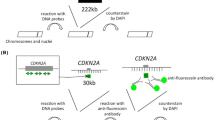Abstract
Conventional karyotyping of Hodgkin's disease (HD) has until now yielded only limited insight into karyotypic characteristics of this discase. For this reason, fluorescence in situ hybridization (FISH) using alphasatellite chromosome-specific probes was applied to paraffin sections of HD tumors in order to verify numerical aberrations suggested to be specific for HD in the literature. The FISH technique was combined with immunohistochemical detection of the CD30 antigen to allow easier identification of the Reed-Sternberg and Hodgkin (RS&H) cells. The number of specific FISH signals per nucleus was determined both in CD30-positive RS&H cells as well as in non-malignant “bystander” cells in order to assess differences in the signal distribution. Contrasted with normal lymphoid cells, the tumor cells in HD were found to be polysomic for at least one of the chromosomes analyzed (1,2,4, and 8). The technique described is a reliable method for confirmation of results obtained from conventional cytogenetics, which is especially suited for archival material or samples not containing dividing cells.
Similar content being viewed by others
References
Ankathil R, Vijayakumar T, Pillai GR, Krishnan Nair M (1992) Chromosomes in Hodgkin's disease-analysis of involved lymph nodes. Neoplasma 39:245–249
Dennis RT, Stock AD, Winberg CD, Sheibani K, Rappaport H (1988) Cytogenetic studies of Hodgkin's disease. Cancer Genet Cytogenet 37:201–208
Hansmann ML, Gödde-Salz E, Hui PK, Müller-Hermelink HK, Lennert K (1986) Cytogenetic findings in nodular paragranuloma (Hodgkin's disease with lymphocytic predominance: nodular) and in progressively transformed germinal centers. Cancer Genet Cytogenet 21:319–325
Henn W, Lehr J, Unteregger G, Ermis A, Zang KD (1990) In situ chromosome preparation technique for simultaneous cytogenetic and immunocytochemical studies on cell cultures of solid tumors. Hum Gen 85:551–554
Holst V, Hughes J, Bromley C, Robinson RA (1994) Confocal microscopy use for accurate chromosome counting in fluorescent in situ hybridization (FISH) of paraffin sections. Mod Pathol 7:163A
Hopman AH, Hooren E van, Kaa CA van de, Vooijs PG, Ramaekers FC (1991) Detection of numerical chromosome aberrations using in situ hybridization in paraffin sections of routinely processed bladder cancers. Mod Pathol 4:503–513
Koduru PRK, Susin M, Schulman P, Catell D, Goh JC, Karp L, Broome JD (1993) Phenotypic and genotypic characterization of Hodgkin's disease. Am J Hematol 44:117–124
Krïstoffersson U, Heim S, Mandahl N, Olsson H, Akerman M, Mitelman F (1987) Cytogenetic studies in Hodgkin's disease. Acta Pathol Microbiol Immunol Scand [A] 95:289–297
Ladanyi M, Parsa NZ, Offit K, Wachtel MS, Filippa DA, Jhanwar SC (1991) Clonal cytogenetic abnormalities in Hodgkin's disease. Genes Chromosomes Cancer 3:294–299
Poppema S, Kaleta J, Hepperle B (1992) Chromosomal abnormalities in patients with Hodgkin's disease: evidence for frequent involvement of the 14q region but infrequent bcl-2 gene rearrangement in Reed-Sternberg cells. J Natl Cancer Inst 84:1789–1793
Schlegelberger B, Weber-Matthiesen K, Himmler A, Bartels H, Sonnen R, Kuse R, Feller AC, Grote W (1994) Cytogenetic findings and results of combined immunophenotyping and karyotyping in Hodgkin's disease. Leukemia 8:72–78
Sharonov S, Chourpa I, Valisa P, Fleury F, Feofanov A, Manfalt M (1994) Confocal spectral imaging analysis. Microsc Analysis 32:23–25
Stock C, Ambros IM, Mann G, Gadner H, Amann G, Amgros PF (1993) Detection of 1p36 deletions in paraffin sections of neuroblastoma tissues. Genes Chromosom Cancer 6:1–9
Teerenhovi L, Lindholm C, Pakkala A, Franssila K, Stein H, Knuutila S (1988) Unique display of a pathologic karyotype in Hodgkin's disease by Reed-Sternberg cells. Cancer Genet Cytogenet 34:305–311
Weber-Matthiesen K, Deerberg J, Müller-Hermelink K, Schlegelberger B, Grote W (1993) Rapid immunophenotypic characterization of chromosomally aberrant cells by the new FICTION method Cytogenet Cell Genet 63:123–125
Weber-Matthiesen K, Deerberg J, Poetsch M, Grotte W, Schlegelberger B (1995) Numerical chromosome aberrations are present within the CD30+ Hodgkin and Reed-Sternberg cells in 100% of analyzed cases of Hodgkin's disease. Blood 86:1464–1468
Author information
Authors and Affiliations
Rights and permissions
About this article
Cite this article
Nolte, M., Werner, M., von Wasielewski, R. et al. Detection of numerical karyotype changes in the giant cells of Hodgkin's lymphomas by a combination of FISH and immunohistochemistry applied to paraffin sections. Histochem Cell Biol 105, 401–404 (1996). https://doi.org/10.1007/BF01463661
Accepted:
Issue Date:
DOI: https://doi.org/10.1007/BF01463661




